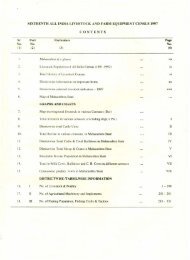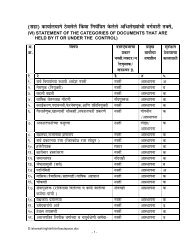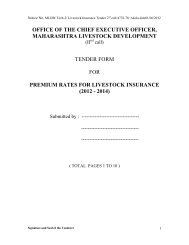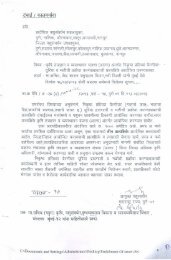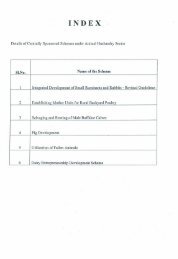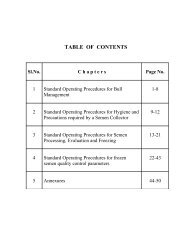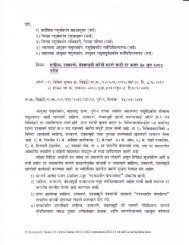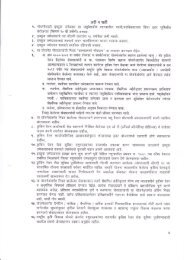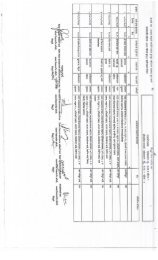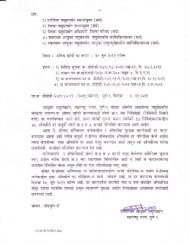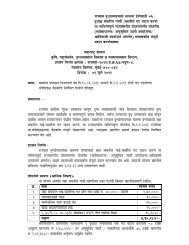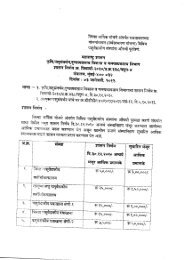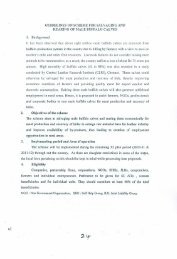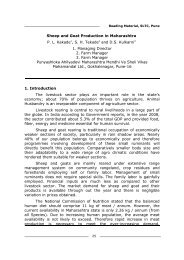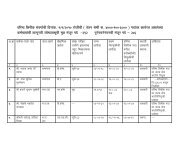Economically Important Parasitic Diseases of animals (10794.94 KB)
Economically Important Parasitic Diseases of animals (10794.94 KB)
Economically Important Parasitic Diseases of animals (10794.94 KB)
Create successful ePaper yourself
Turn your PDF publications into a flip-book with our unique Google optimized e-Paper software.
<strong>Economically</strong> important<br />
<strong>Parasitic</strong> <strong>Diseases</strong> <strong>of</strong><br />
Animals<br />
Dr.V.V.Limaye.<br />
Assistant Commissioner <strong>of</strong> A.H.
Parasites – A serious threat<br />
More attention – bacterial and viral diseases<br />
More mortality and morbidity<br />
<strong>Parasitic</strong> diseases pose a serious threat to animal<br />
health – more difficult to control.<br />
Parasite has a better capacity to overcome host<br />
resistance.<br />
Vectors if involved more difficult to control – on the<br />
animal and in the environment.<br />
Resistance to Acaricides<br />
Parasites remain viable in the vector for long time<br />
Vaccines not available<br />
Diagnostic techniques not very well developed.
Major <strong>Diseases</strong> <strong>of</strong> Economic Importance<br />
Theileriosis<br />
Trypanosomiasis<br />
Babesiosis<br />
Fascioliasis<br />
Coccidiosis<br />
Trichomoniasis
Theileriosis<br />
Theileriois is an infectious disease <strong>of</strong> cattle<br />
caused by a protozoan parasite and<br />
characterised by enlargement <strong>of</strong> lymph nodes,<br />
pulmonary odema, haemorrhages on kidney and<br />
liver, ulcers in abomassum and cattarhal<br />
enteritis.
Pathogenesis<br />
Theileria annulata. Theileria parva<br />
Transmitted through bite <strong>of</strong> ticks – Hyalomma<br />
Entry <strong>of</strong> the parasite – Sporozoite stage – remains in<br />
blood circulation - enters the erythrocytes- don’t<br />
multiply<br />
Multiplication – lymphocytes – schizonts
Pathogenesis<br />
Infected lymphocytes – diff. lymphoblast – macro -<br />
micro schizonts<br />
Schizonts differentiate to merozoites<br />
Merozoites infect the RBC – assume different forms.<br />
Rapidly multiplying - schizonts – massive destruction<br />
<strong>of</strong> lymphoid cells
Clinical Symptoms – Postmortem lesions<br />
High fever, anaemia,<br />
Enlargement <strong>of</strong> lymphnodes and spleen<br />
Erosions and ulcers in abomassum<br />
Pulmonary odema<br />
Hemorrhages on epicardium<br />
Catarrhal enteritis
Postmortem Lesions – Theileriosis<br />
Pulmonary Odema<br />
Enlargement <strong>of</strong> spleen
Diagnosis<br />
Blood smear examination<br />
Lymph node biopsy smear.<br />
Serological tests.<br />
PCR
Peripheral blood smear from a cow with<br />
Theileriosis. Arrow heads denotes piroplasms in<br />
erythrocytes – cigar shaped, diamond ring shaped.
Schizonts in lymphocytes and Piroplasms in red<br />
blood cells. – Giemsa stain
Wright’s-stained impression smear from an enlarged<br />
lymph node <strong>of</strong> a cow Theileriosis.<br />
Numerous large lymphoblasts with irregular nuclear<br />
outlines and prominent nucleoli
Treatment and Control<br />
Oytetracycline 15 -20 mg / Kg. B.W. 5 – 7 days<br />
Inj Buparvaquone ( Butalex ) 2.5 mg / Kg. B.W. I/M –<br />
single injection.<br />
Berenil 0.8 to 1.6 gm / 100kg B.W. I / M.<br />
Vaccine : Rakshavac T
Life Cycle <strong>of</strong> Theileria
Trypanosomiasis<br />
Trypanosoma is an infectious disease <strong>of</strong><br />
cattle and buffaloes caused by<br />
protozoan parasite and characterised by<br />
intermittent fever, dullness, anorexia,<br />
anemia, occular discharge, improper<br />
gait, circling, shaking <strong>of</strong> head,<br />
emaciation, ulceration on tongue and<br />
gastric mucosa and gelatinous exudate<br />
in subcutaneous region.
Dourine<br />
Horses – T. equipardum<br />
Veneral disease transmitted through coitus<br />
Swelling <strong>of</strong> external genitalia<br />
Vaginal – urethral discharge
Pathogenesis<br />
Transmitted though bites <strong>of</strong> Tabanus flies.<br />
Stomoxys and Haematopota<br />
Carrier <strong>animals</strong> remain as a potential source <strong>of</strong><br />
infection.<br />
Multiply by binary fission – Parasitaemia.<br />
Parasites – variable surface glycoproteins –<br />
continuous exposure <strong>of</strong> immune system –<br />
hyperplasia <strong>of</strong> spleen.<br />
Chronic cases – Ag + Ab complexes –<br />
glomerulonephritis and vasculitis.
Symptoms<br />
High fever<br />
Dyspnoea<br />
Paraplegia<br />
Emasciation<br />
Odema <strong>of</strong> dependant parts <strong>of</strong> the body<br />
Conjunctivitis and Keratitis<br />
Occular discharge<br />
Improper gait, circling, shaking <strong>of</strong> head
Postmortem Lesions<br />
Emasciated carcass<br />
Enlargement <strong>of</strong> spleen.<br />
Gelatinous exudate in subcutaneous region<br />
Congestion <strong>of</strong> abomassum and intestines<br />
Petechiae on kidney, liver and heart<br />
Ulcers on tongue.
Diagnosis<br />
Thick and thin blood smear examination<br />
Giemsa or Leishman’s stain.<br />
Concentration techniques<br />
Wet mount<br />
Mice inoculation<br />
IFA<br />
ELISA
Trypanosoma FITC – Stain.
Trypanosoma in blood smear – Giemsa<br />
stain.
Treatment<br />
Quinapyramine ( Triquin, Tribexin ) 20% , 3-5<br />
mg/Kg B.W. S/c.<br />
Suramine ( Naganol, Antrypol) 10 %, 1 mg /<br />
kg B.W. I /V.<br />
Dimenazine ( Berenil ) 20 %, 8 – 10 mg / kg<br />
B.W. I/ M.<br />
Supportive treatment :<br />
Dextrose Inj, 25 % , I / V.<br />
Liver extract, B.complex inj.
Control<br />
Detection , isolation and treatment <strong>of</strong> affected<br />
<strong>animals</strong>.<br />
Control <strong>of</strong> vectors – spraying <strong>of</strong> insecticides<br />
Preventive – antrycide prosalt<br />
Hygiene at the farms<br />
No vaccine available.
Babesiosis<br />
Babesia is an infectious disease <strong>of</strong> cattle and<br />
buffaloes caused by protozoan parasite and<br />
characterised by hemoglobinuria, anaemia,<br />
petechiae and echymoses on serous membranes,<br />
icterus, pulmonary odema and gastroenteritis.
Etiology<br />
Cattle<br />
Babesia bigemina<br />
Babesia bovis<br />
Sheep and Goat<br />
B. ovis B. motasi<br />
Horses<br />
B. equi
Pathogenesis<br />
Transmission through ticks – transovarian<br />
transmission.<br />
Incubation period – 5 to 10 days<br />
Parasite multiplies in peripheral blood.<br />
Intravascular hemolysis – hemoglobinuria<br />
Infected erythrocytes liberate some enzymes –<br />
interact with components <strong>of</strong> blood.
Symptoms and Postmortem findings<br />
High fever, Anaemia<br />
Icterus, Hemoglobinuria<br />
Enlargement <strong>of</strong> liver & spleen<br />
Odema in lungs<br />
Petechiae and ecchymoses in kidneys, lung,<br />
liver and spleen.<br />
Congestion in gastrointestinal tract.
Diagnosis<br />
Demonstration <strong>of</strong> parasite in blood smears<br />
Leishman, Giemsa stain<br />
Immunodiagnostic tests<br />
IFA<br />
ELISA<br />
PCR
Babesia – parasite in RBCs
Babesia – parasite in RBCs
Life Cycle <strong>of</strong> Babesia
Treatment and Prevention / control<br />
Berenil ( Diminazine ) 0.8 – 1.6 gm / 100 kg B.W.<br />
Liver extract, B complex, iron preparations<br />
Blood transfusions<br />
No vaccines<br />
Control <strong>of</strong> ticks<br />
Timely treatment
Fascioliasis<br />
Caused by Fasciola gigantica and F. hepatica.<br />
F. gigantica common in India<br />
Most common and ecomomically important<br />
disease <strong>of</strong> sheep.<br />
Large <strong>animals</strong> rarely infected clinically
Life stages<br />
Parasite matures in bile duct – eggs pass down<br />
the bile ducts – excreted in faeces – eggs hatch<br />
– miracidia – snail – sporocysts in snail tissue<br />
– cercaria, 5 to 8 weeks latter – cercaria encyst<br />
– metacercaria – ingested by host – cercaria<br />
liberated in G.I. tract – penetrate the intestinal<br />
wall – migrate thru peritoneal cavity – liver –<br />
tracts in liver parenchyma.
Pathogenesis<br />
Acute hepatic Fascioliasis<br />
ingestion <strong>of</strong> large no. <strong>of</strong> metacerceria<br />
invasion <strong>of</strong> liver by masses <strong>of</strong> young flukes<br />
Immature flukes tissue feeders<br />
sufficient parenchyma destroyed<br />
acute hepatic insufficency.<br />
Chronic hepatic fascioliasis<br />
Develops slowly due to adult flukes<br />
cholangitis, biliary obstruction, destruc. <strong>of</strong><br />
hepatic tissue and fibrosis.
Acute Fasc.<br />
Clinical Signs<br />
Sudden death, weakness, lack <strong>of</strong> appetite, pallour and<br />
odema, pain when pressure exerted in area <strong>of</strong> the liver.<br />
Young sheep, death in 1- 2 weeks<br />
Chronic Fasc.<br />
Small no. <strong>of</strong> metacercaria ingested over a long period.<br />
loose weight, submandibular odema, loose wool,<br />
death in 2- 3 months.
Fascioliasis – Bottle jaw
Postmortem findings<br />
Acute Fasc.<br />
Postmortem findings<br />
Badly damaged, swollen liver, capsules show many<br />
small perforations and subcapsular hemorrhages,<br />
parenchyma shows tracts <strong>of</strong> damaged tissue and liver<br />
and is much more friable than normal.<br />
Chronic Fasc.<br />
Presence <strong>of</strong> large leaf like flukes in grossly enlarged<br />
and thickened bile duct.<br />
Blockage <strong>of</strong> bile ducts – flukes and cellular debris<br />
Liver Parenchyma –extensive fibrosis and calcification
Diagnosis, Treatment<br />
Faecal sample examination, ELISA<br />
Oxyclozanide ( Distodin ) 10 -15 mg / Kg. BW. Orally<br />
Nitroxynil ( Inj. Trodex ) 10 mg / Kg.B.W. S / C.<br />
Liver extracts, B. complex , other supportive
Control<br />
Faecal sample examination – treatment<br />
Control <strong>of</strong> snails – molluscicide – esp.<br />
summer.<br />
Stall feeding – avoid grazing in marshy areas,<br />
banks <strong>of</strong> rivers or ponds.<br />
Animals treated with approp. Flukicide just at<br />
the onset <strong>of</strong> rains.
Coccidiosis<br />
Coccidiosis is a contagious enteritis caused by infection<br />
with Eimeria spp., which occurs in all domestic<br />
<strong>animals</strong>. Subclinical infection may occur or there may<br />
be diarrhoea or dysentery.<br />
E. zuernii, E. Bovis } Cattle<br />
E. arloingi } Sheep.<br />
Coccidia are host specific.<br />
Cross immunity between diff. species <strong>of</strong> coccidia<br />
does not occur.<br />
Coccidial life cycle is self limiting
Pathogenesis<br />
Oocysts – sporozoites – invade endothelial cells - villi –<br />
schizont – matures – merozoites – new epithelial cells<br />
infected – second generation schizont – second – gen<br />
merozoites –invade new epith. cells – microgamete &<br />
macrogamete – fertilisation – oocyst.<br />
second generation schizont – fertilization <strong>of</strong> gametes- –<br />
structural and functional lesions <strong>of</strong> large intestine.<br />
Cells containing schizonts and gamonts slough and<br />
cause hemorrhage
Intestine<br />
Normal and infected epithelium
Clinical signs<br />
Incubation period 15 – 30 days<br />
Sudden onset <strong>of</strong> foul smelling diarrhoea<br />
Fluid faeces containing blood and mucous<br />
Dark tarry staining <strong>of</strong> faeces – streaks or clots<br />
<strong>of</strong> blood.<br />
Perinium and tail smeared with faeces<br />
Decrease in appetite and poor feed conversion.
Postmortem findings<br />
Hemorrhagic enteritis<br />
Thickening <strong>of</strong> mucosa <strong>of</strong> caecum, colon, rectum and<br />
ileum.<br />
Ulceration and sloughing <strong>of</strong> mucosa<br />
Whole blood or blood stained faeces in lumen <strong>of</strong> large<br />
intestine.<br />
Diagnosis : Faecal sample examination<br />
Intestinal scraping
Treatment & Control<br />
No vaccine. Those available – not efficient.<br />
Chemotherapeutic agents<br />
Coccidiostatic<br />
Coccidiocidal<br />
Affected <strong>animals</strong> isolated and treated<br />
Overcrowding be avoided<br />
Feed and water should be kept at a higher level<br />
Spreading <strong>of</strong> lime – shades be kept dry.
Trichomoniasis<br />
Trichomoniais is a protozoan parasitic disease<br />
<strong>of</strong> cattle and buffaloes caused by Trichomonas<br />
sp. and characterised by abortion, vaginitis,<br />
metritis and balanitis.<br />
Trichomonas foetus.
Trichomonas - protozoa
Pathogenesis<br />
Confined to all regions <strong>of</strong> reproductive tracts.<br />
Trophozoites attach to surface <strong>of</strong> epithelial<br />
cells lining reproductive tract.<br />
Trophozoites multiply by binary fission<br />
Abortion due to cytotoxicity <strong>of</strong> maternal<br />
endometrium<br />
A battery <strong>of</strong> enzymes <strong>of</strong> the parasite acts<br />
against host proteins.
Clinical signs<br />
Abortion and pyometra – first signs noticed in<br />
the herd.<br />
Abortion in 1 st third to half <strong>of</strong> gestation<br />
In bulls scant preputial discharge may be noted<br />
in first few days <strong>of</strong> infection.
Postmortem and Diagnosis<br />
In aborted fotuses :<br />
Enlarged liver<br />
Non inflated, enlarged, firm lungs<br />
Placenta odematous<br />
Diagnosis<br />
Preputial washings or smegma.<br />
Vaginal or Uterine secretions<br />
Characteristic jerky, tumbling motion.<br />
CPLM or Diamonds medium –culture the parasite
Control<br />
Screen all the <strong>animals</strong> in the herd<br />
Bulls are carriers – cull infected ones<br />
Infected cows - give them breeding rest 6 mths<br />
A.I. chances <strong>of</strong> transmitting the infection are least<br />
TrichGuard – Fort Dodge, used to vaccinate cows. Two<br />
inj 2 to 4 weeks apart, prior to breeding<br />
Treatment not effective – Ipronidazole may be tried.
A Seroepidemiological and<br />
Parasitological Study <strong>of</strong> Prevalence<br />
<strong>of</strong> Trypanosomiasis in<br />
Animals in Maharashtra.<br />
15 July 2008 – June 2009.
Objectives :<br />
Parasitological and serological study <strong>of</strong> incidence <strong>of</strong><br />
trpanosomiasis in <strong>animals</strong> in Maharashtra.<br />
Parasitological study <strong>of</strong> Tabanus flies and rodent fleas.<br />
Study <strong>of</strong> prevalence <strong>of</strong> trypanosomiasis in rodents.<br />
Epidemiological study <strong>of</strong> trypanosomiasis in <strong>animals</strong>.
Geographical area<br />
High risk areas<br />
Low risk areas.<br />
Action Plan:<br />
High risk areas comprise <strong>of</strong> :<br />
a.Village Shivni, Tal. Sindewahi, Dist.,Chandrapur.<br />
b. Village Paud, Tal. Mulshi, Dist. , Pune.<br />
c. Andheri suburb, Mumbai.<br />
20 % <strong>of</strong> animal population<br />
II. Low risk areas comprise <strong>of</strong> :<br />
a. All talukas in Chandrapur, Gadchiroli, Hingoli, Beed,<br />
Amravati, Jalgaon, Pune and Raigad districts.<br />
100 blood samples and serum samples from each taluka<br />
showing clinical signs suggestive <strong>of</strong> Surra.<br />
30 C + 30 B + 20 G + 20 S
Methodology :<br />
1. Screening <strong>of</strong> blood smears ( thick & thin ) for<br />
trypanosomes after staining them with<br />
Leishmans stain.<br />
2. Biological Test : Detection <strong>of</strong> trypanosomes<br />
in blood samples by inoculation in mice.<br />
3. Detection <strong>of</strong> antitrypanosomal antibodies in<br />
serum samples by IFA / ELISA or serum<br />
agglutination test.
Results anticipated :<br />
The study will provide valuable data on the following<br />
aspects <strong>of</strong> the disease :<br />
1. Incidence <strong>of</strong> trypanosomiasis in <strong>animals</strong> in High<br />
and Low risk areas.<br />
2. Antibody pr<strong>of</strong>iles <strong>of</strong> trypanosomiasis in <strong>animals</strong><br />
in High and low risk areas.<br />
3. Species <strong>of</strong> Tabanus flies involved as biological<br />
vectors in active or passive transmission <strong>of</strong> the<br />
disease.<br />
4. Prevalance <strong>of</strong> trypanosomiasis in rodents and<br />
rodent fleas.<br />
5. Zoonotic aspect <strong>of</strong> the disease and possible<br />
vectors involved in transmission <strong>of</strong> the disease to<br />
human beings.
Thank You



